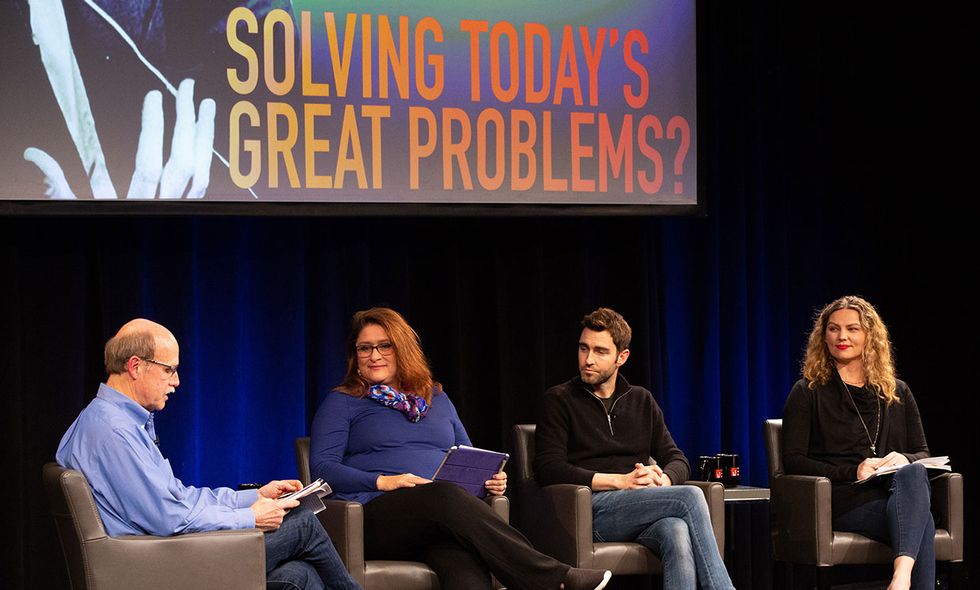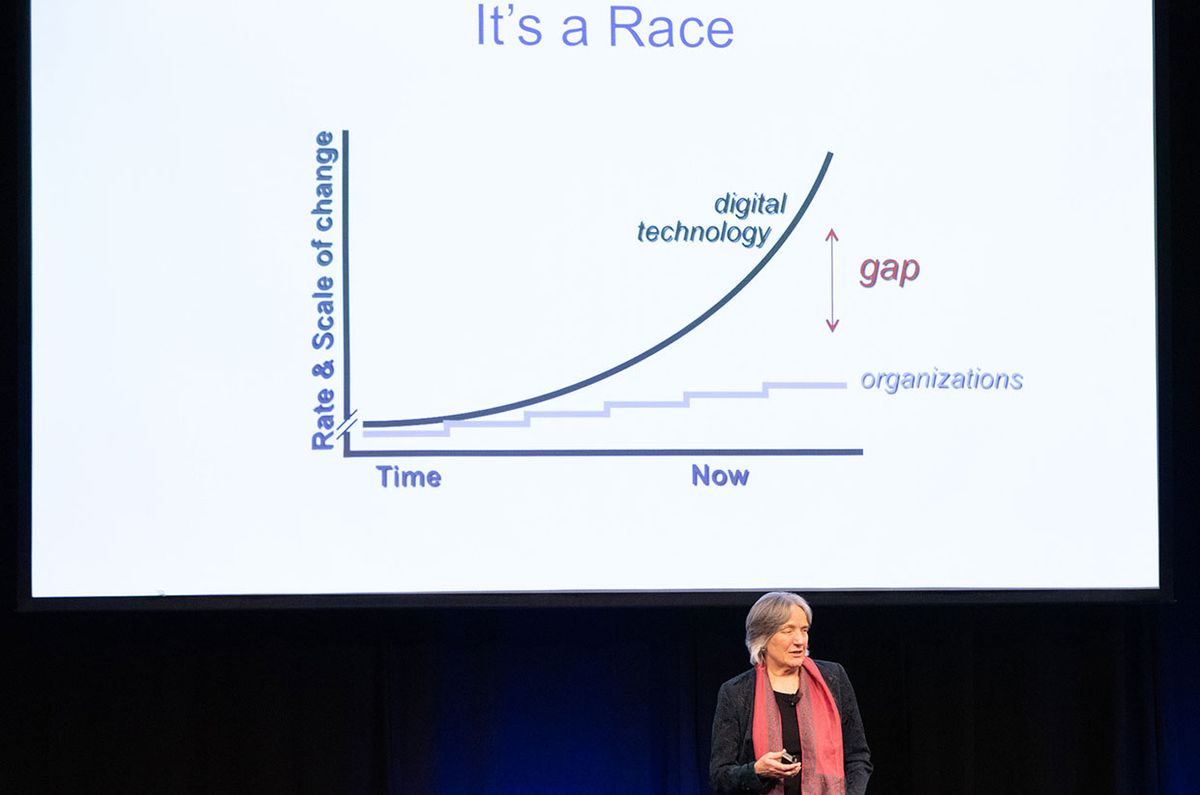Fifty years ago this month Doug Engelbart demonstrated what we’ve come to know as computing—the mouse, hypertext, and windows. His goal wasn’t to revolutionize computing per se, it was to give people better tools for collaboration, which he hoped would lead to better ways to fix the real problems of society. (Moving a cursor around a display, while sometimes challenging before the mouse, was not a real societal problem.)
“He thought the single greatest existential challenge of our time was to raise the curve on our ability to collectively solve problems,” said Christina Engelbart, Doug Engelbart’s daughter, who spoke at the Computer History Museum in Mountain View, Calif., this week, along with a group of tech execs, futurists, and other people interested in tackling today’s big problems.
How are we doing in terms of meeting that challenge? According to Christina, her father, who died in 2013, would say, “Great effort guys, but there is one problem.” That problem involves technology evolving on a much faster path than the organizations that have to manage it. “The explosion of digital technology unchecked is a threat multiplier, and that gap is a cause for concern,” she said.
Christina remains hopeful that organizations can catch up, and finally realize her father’s vision of using technology to find answers to critical problems.
To get there, said futurist Paul Saffo, “We need more Engelbarts, more people who are long distance thinkers, long distance doers, tackling the greatest challenges that lay ahead.”
Saffo then brought three people on stage who hope to tackle big issues—climate change, political dysfunction, and nuclear proliferation—with a long term perspective. Here’s what those would-be Engelbarts are doing:

On climate change:
Stanford marine biologist Erika Woolsey has long been researching coral reefs. Watching the dramatic bleaching of the Great Barrier Reef in the past few years, Woolsey says she “got to thinking that maybe knowledge isn’t the limiting factor, it’s changing science discovery into understanding and action.”
To push understanding forward, Woolsey co-founded the Hydrous. Initially, the organization focused on creating open access 3D models of coral reefs; it is now moving on to develop ocean experiences for virtual reality.
“I believe you can’t get people to protect something they haven’t experienced. The ocean is huge, the ocean acidification problem is huge. And the IPCC report says we basically have 12 years to reduce our carbon emissions by 40 percent to hit the target of warming to only 1.5 degrees [Celsius] instead of 2 degrees. That’s the difference between having coral reefs completely gone everywhere on earth and still having coral reefs that can support vibrancy. To reach this goal, we need rapid and unprecedented change.”
To get there, Woolsey believes, as Engelbart did, that technology can be a tool “in raising the global IQ.”
For Engelbart, an important step in the development of tech tools was the demo. Woolsey would like to do a demo of her own. “I would take people in landlocked states, where they don’t have any access to the ocean, on virtual dives. These are states that have great influence in climate policy. I would like to unlock the ocean for those in landlocked states, to share the beauty and wonder of this ecosystem that their behaviors affect.”
On political dysfunction:
Change.org CEO Ben Rattray says democratic systems are so broken today that people’s actual preferences aren’t represented by their votes.
“We celebrate how old our political system is,” he says, which is odd. “In other areas, we celebrate innovation. If you had a chance to create a new society with today’s technology, you wouldn’t create the system we have today.”
Rattray envisions a new democratic system, one that encourages people to find experts that they trust and designate them as proxies to make decisions on their behalf. In this system, anyone could propose legislation; proposals would move forward based on reactions from that broad field of trusted experts.
“The idea of leveraging trust is not new,” Rattray says. Google is basically a trust network based on hyperlinks. Ebay would never work without trust, or Google, or Lyft, or Airbnb. We don’t have this for political information, but we have it for commerce.”
He admits he doesn’t know if this approach would be ideal, but argues that it’s at least worth thinking about. He pointed to the poor rates of voting in the United States, and said, “If you have a product that nobody is buying, do you condemn your non-buyers or make a better product?”
Rattry, if he followed the Engelbart path from idea to demo, would prototype “a dynamic network of people who can indicate proxy experts that they respect to represent them on an issue and to source legislation, and then see what the policy outcomes would be.” That would take a while to scale, he indicated.
But, he said, you don’t have to wait for a whole new system to make democracy more functional. An even simple change could make a big difference. Consider, he said, ranked choice voting, a system in which voters can select multiple candidates in order of preference, and, should no candidate get a majority of votes, allows election officials to conduct an instant run-off.
On nuclear proliferation:
NSquare managing director Erika Gregory pointed out that the way Americans think of nuclear weapons was locked in more than 70 years ago when the U.S. first developed its nuclear capability, setting up a system based on deterrence in which decisions to launch are by no means democratic. Those early nuclear strategies shaped politics, culture, and beyond, she said, and “has actually hurt [our democracy]; there is not a less democratic process than nuclear weapons. We created an insular group of people and ceded responsibilities for decisions to them.”
Now, she said, that era’s reliance on deterrence “is breaking down, as non-state actors are getting nuclear material and a guy dropping a socket down a missile silo nearly destroys a chunk of the nation.”
Gregory is building a network of diverse teams to work on the problem, “not accepting that nuclear weapons are the purview of only a few…
We are looking at a bias towards openness, an invitation for many people to engage, for all of you in technology to make a difference. These are the kinds of networks I like to think that Doug Engelbart dreamed of.”
Gregory already had her demo—last month, at the Rhode Island School of Design. “We were asked to show proof of concept, that collaborative teams working across sectors, with experts in the room, could produce better results than experts alone. Our first demo [was] a data fusion program that aggregates open source data to allow journalists and academics to make sense of nuclear proliferation around the world.”
A version of this post appears in the February 2019 print magazine as “What Would Doug Engelbart Do?”
